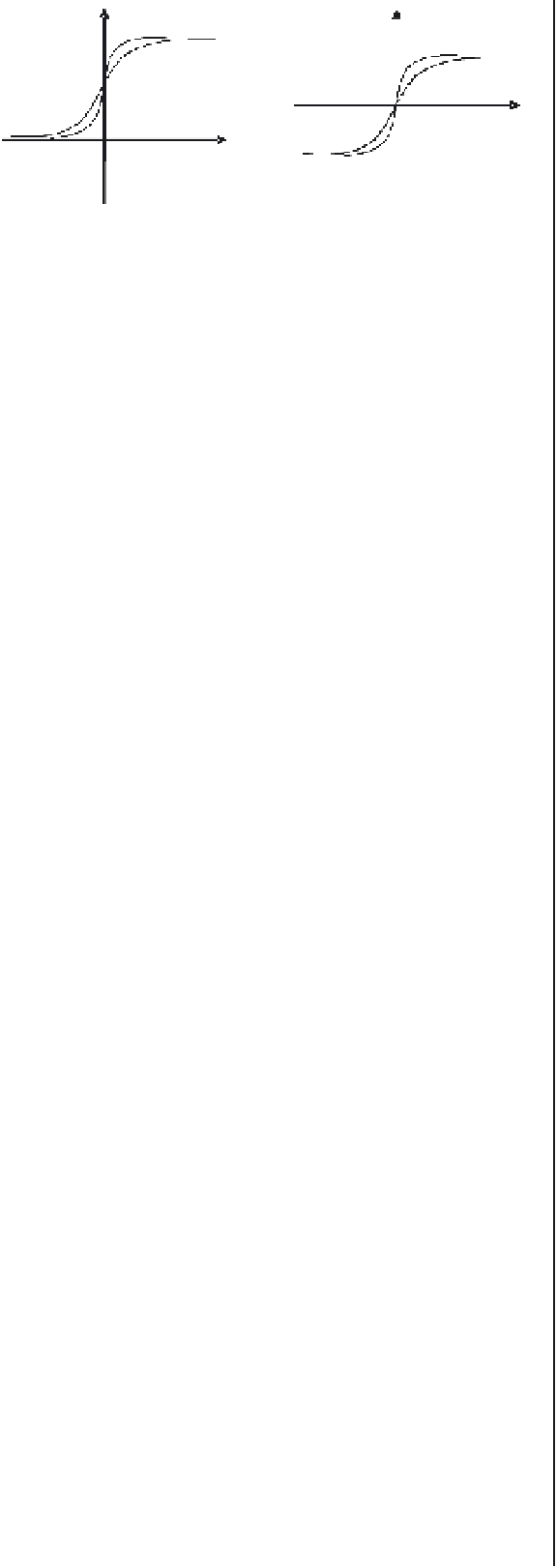Environmental Engineering Reference
In-Depth Information
formula of the SGD algorithm to improve training efficiency.
Momentum is a variable used to reduce the training time
and avoid oscillations around the minimum. While the SGD
algorithm adjusts the weights along the steepest gradient descent
of the performance function, the GDM algorithm concerns
both the current gradient descent and the recent changes of
the weights. Therefore, the GDM algorithm can use a larger
learning rate to speed up the training process with lower risk of
oscillations.
The SGD and GDM algorithms consider both the magnitude
and the sign of the gradient of the performance function. These
two algorithms usually take a long time to converge. The resilient
propagation (RP) algorithm proposed by Riedmiller and Braun
(1993) attempts to speed up the training process by eliminating
the negative impacts of the magnitudes of the partial derivatives.
It uses the sign of the derivatives of the classification error to
determine the direction of the weight update. The magnitude
of the weight update is defined by an individual variable which
increases when the derivatives for two successive iterations have
the same sign, otherwise decreases. Generally, the RP algorithm
is much faster than other back-propagation training algorithms.
y
y
T<c
T<c
1
1
T>c
T > c
0
x
0
x
−
1
A
B
FIGURE 7.2
Curves of activation functions as related to
different threshold (T) values, given that c is any con-
stant between 0 and 1. (A) log-sig function and (B) tan-sig
function.
most commonly used (Dawson and Wilby, 2001). There is a
rich pool of training algorithms varying by their origins, local
or global perspective, or learning mode. They are rooted in
various techniques, such as optimum filtering, neurobiology, or
statistical mechanics. Local learning algorithms adjust weights by
using localized input signals and localized derivative of the error
function, while global algorithms consider all input signals. Based
on the learning mode, training algorithms can be grouped into
either a supervised, unsupervised, or hybrid paradigm. Reviews
on these algorithms are given elsewhere (e.g., Bishop, 1995; Jain,
Mao and Mohiuddin, 1996; Haykin, 1999; Principe, Euliano and
Lefebvre, 2000). Here, we focus on three groups of supervised
training methods that have been commonly used to train the
MLP neural networks: back-propagation, conjugate gradient,
and quasi-Newton methods; they differ in the ways by which the
direction and magnitude of weight adjustments are calculated
(Table 7.2).
7.2.3.2
Conjugate gradient method
The basic back-propagation method adjusts the weights along
the steepest descent direction. However, this can be quite time-
consuming due to the fixed learning rate. Rather than using the
magnitude of the gradient descent and a user-defined learning
rate, the conjugate gradient method employs a series of line
searches along conjugate directions to determine the optimal
step size of the weight update, thus allowing fast convergence.
Specifically, the conjugate gradient training comprises two steps.
The first step is to search the local minimum in error along a
certain search direction; the weights will be adjusted to the local
minimum point. The second step is to compute the conjugate
of the previous search direction as the new search direction; the
global minimum error is approached through iterations. This
group of training method includes several commonly used algo-
rithms, such as Fletcher-Reeves (CGF), Polak-Ribiere (CGP),
Powell-Beale (CGB), and scaled conjugate gradient (SCG) algo-
rithms (see Table 7.2).
The CGF algorithm calculates the mutually conjugate direc-
tions of searchwith respect to theHessianmatrix directly fromthe
function evaluation and the gradient evaluation, but without the
direct evaluation of the Hessian of the function. It computes
the coefficient (beta) as a ratio of the norm squared of the current
gradient to the norm squared of the previous gradient. The CGP
algorithm is similar to the CGF algorithm, differing only in the
coefficient (beta) computation. It computes beta as the inner
product of the previous change in the gradient with the current
gradient divided by the norm squared of the previous gradient.
Using the same learning model used by the CGF algorithm to
compute the conjugate direction, the CGB algorithm, however,
resets the search direction to the negative of the gradient if the
error function is non-quadratic. Finally, the SCG algorithm is a
variation of the conjugate gradient method with a scaled step size.
It combines the model-trust region approach with the conjugate
gradient approach to scale the step size.
7.2.3.1
Back-propagation method
Due to its transparency and effectiveness, the back-propagation
method has been widely used in neural network training (Duda,
Hart and Stork, 2001). It adjusts the weights of networks through
iterations based upon training samples and their desired output.
On each iteration, the derivatives of the classification error as
functions of the weights are computed to determine the direction
andmagnitude of theweight update. Through these iterations, the
weights of networks are gradually optimized. Several commonly
used back-propagation training algorithms include the steepest
gradient descent (SGD), the gradient descent with momentum
(GDM), and the resilient propagation (RP) algorithms.
The SGD algorithm is the simplest back-propagation algo-
rithm, which determines the direction and magnitude of the
weights by the derivatives of the classification error with respect
to any weight. It incorporates a user-defined learning rate. It is
difficult to choose an appropriate learning rate. If the learning
rate is set too large, the algorithm may end up with oscillations
around the minimum error; otherwise, the training may be inef-
ficient. In addition, a fixed learning rate causes small changes in
the weights even though the weights are far from their optimal
values. Consequently, this algorithmusually takesmore iterations
to converge.
The GDM algorithm is an advanced gradient descent
approach adding a momentum item in the weight adjustment










Search WWH ::

Custom Search